
12 minute read
Sporting
CRICKET

Advertisement
LET THE GAMES BEGIN
At the fi rst round of the Triangle Cricket League playoff s in Morrisville, Royals batter Mayur Choudhary cheers for teammate Satbir Minhas, who had just scored a half-century, accounting for 50 runs without getting out.
triumphs in the Triangle
Cby ILINA EWEN CHANCES ARE, WHEN NORTH CAROLINIANS HEAR THE WORD CRICKET, they’re thinking bugs. Not the game of ball, bats, and wickets fi rst played in England in the 16th century, now second only to soccer as the world’s most popular sport. Amazingly, cricket has 120 million players across the world, mostly in former outposts of the British Empire. Now, they hail om the Triangle, too.
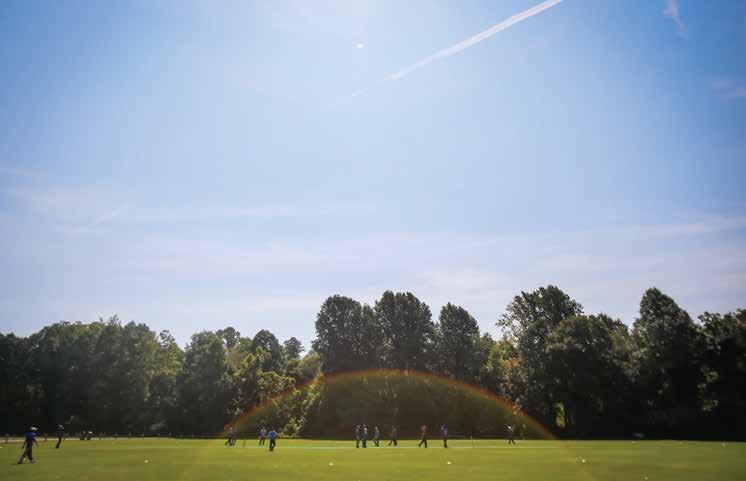
Here, cricket is a sporty thread knitting together the Triangle’s rich immigrant fabric. Players from almost every country that has a national team – including Australia, England, India, New Zealand, Pakistan, Sri Lanka, South Africa, Guyana, and Barbados – play in the quickly-growing Triangle Cricket League.
The League was formally established in 2010 when 10 founding teams from the Mid-Atlantic Cricket Conference split off to form their own group. The sport’s galloping growth had begun to make it difficult to manage teams all the way from Virginia to South Carolina, and local players decided a local focus was necessary.
One of TCL’s primary objectives is to promote the sport among youth in the community, both those born into cricket families and those who are foreign to the game.
My family is a little bit of both. Until a recent month in India, my 12- and 10-year-old sons’ only exposure to cricket was from the film Million Dollar Arm. But once we landed on Indian soil, they clamored to play the sport themselves. My cricket-fanatic uncle happily indulged the boys, and they quickly caught the bug.
When we came home, we brought with us two prized souvenir cricket bats emblazoned with the signature of revered former Indian cricket captain Sachin Tendulkar, said to be the greatest batsman of all time, and a new sport to fit into our lives.
The league is invested in developing the youth cricket program and is now on its way to establishing a foundation of in-

SPORTING

WICKETS AND BATSMEN
Clockwise from top left: The wicket consists of three stumps with two spindle-like "bails" resting on top. The batsman's job is to protect the wicket from the bowler, who tries to throw the ball and knock the "bails" off of the stumps.
Royals batsman Satbir Minhas practices his stroke before the start of the match.
Royals teammates, from left, Suhail Warrich, Faraz Rafi, and Rinku Rana chat on the edge of the field while their team bats.
Morrisville Warriors batsman Santosh Sarikonda looks on as he waits for his opportunity to enter the game as a batsman.


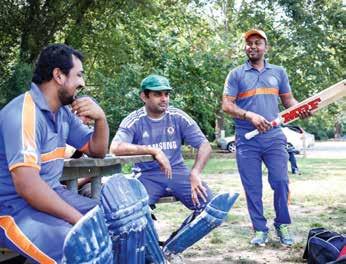
struction and competition among children ages 6 to 17. My own sons joined a team and have introduced the sport to neighborhood kids who can be found playing in the park in front of our home. Passersby stop to watch and drivers roll down their windows, exclaiming in awe, “Wow, is that cricket you guys are playing?”
While cricket might appear confusing upon first glance, it is actually a simple sport to pick up and follow. Like baseball, players use a ball and bat, but the similarity ends there. Cricket is a relatively simple game that is easily modified to suit restrictions of space and time. You can play it with a few players in a neighborhood, or as many as 30 on a larger field. Like most team sports, cricket emphasizes sportsmanship and conduct. It’s a true “gentleman’s game,” cloaked in history and tradition.
That’s clear when you speak to the people making this sport take root in North Carolina soil. “Cricket provides room for thoughtful strategy or blind faith, for determined resistance or reckless abandon, for focused assault or obdurate defense; but most importantly, it offers a level playing field for all,” says Anirudh Ullal, Secretary of the Triangle Cricket League.
Most players in the Triangle Cricket League played the sport from a young age. In many countries where cricket reigns, neighborhood children play with a shared bat, ball, and rudimentary markings on a makeshift field, much like baseball’s sandlots. That’s why the league is focused on bringing the sport to a new generation here, one without its own cricket tradition. Adults and children both can attend cricket camps and workshops with the league to learn the basics and participate in pick-up games.
Even my Wisconsin-bred husband – who had never heard of cricket growing up – has been bitten by the bug. He’s joining a league too.

Check out trianglecricketleague.org for more information or to join a league (no experience needed). Email the league officers at info@trianglecricketleague.org to get more details. See all the league happenings on Facebook at facebook.com/tclcricket.

RAMENSUNDAYS
JoinuseverySundayeveningatBasaninDurham’sAmerican TobaccoCampus.ChefToshioandhisculinaryteamcreatea specialramendishguaranteedbethebestyou’veevertasted. Thisramenwillbeavailablestartingat5p.m.eachSunday eveningandwillbeavailableonlywhilesupplieslast.Makeyour reservationsearlyasthesedeliciousnoodleswillsurelyrunout. Tocompletetheexperiencemakesureyoutryyourhandat oneofourdelicioussakesorcraftcocktails.Notintoramen?All ourrestaurantshavetastysoupstowarmyoursoul.Visitthem onlineatEschelonExperiences.com.Cheers!
THEESCHELONRESTAURANT&EVENTVENUEFAMILY
TheOXFORD



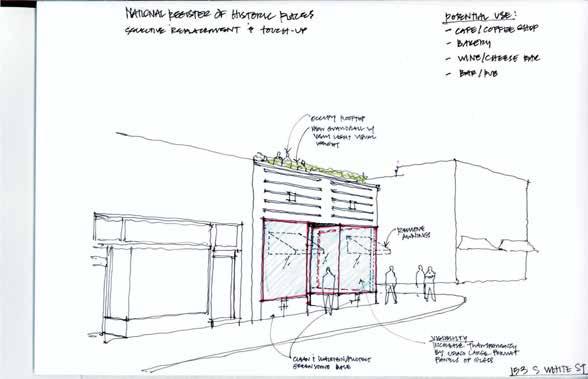
WAKE FOREST en charrette
Twelve Raleigh architects rethink a community’s downtown
by J. MICHAEL WELTON
OOn a cool, rainy Saturday afternoon in early October, three intrepid women – two architects and a landscape architect – ventured out, on foot, from Town Hall in Wake Forest. They were determined to locate a holy grail in the surrounding landscape – a natural water feature to enhance a new urban plan for the nearly 200-year-old town.
The three were part of a team of 12 Raleigh architects who’d been invited by Wake Forest Downtown, a nonprofit charged with fostering the health and vitality of downtown, to re-imagine it. The architects were working en charrette – a 19th-century French term from the Ecole des Beaux-Arts in Paris. It’s shorthand for an intense, day-long design workshop.
DOWNTOWN REIMAGINED
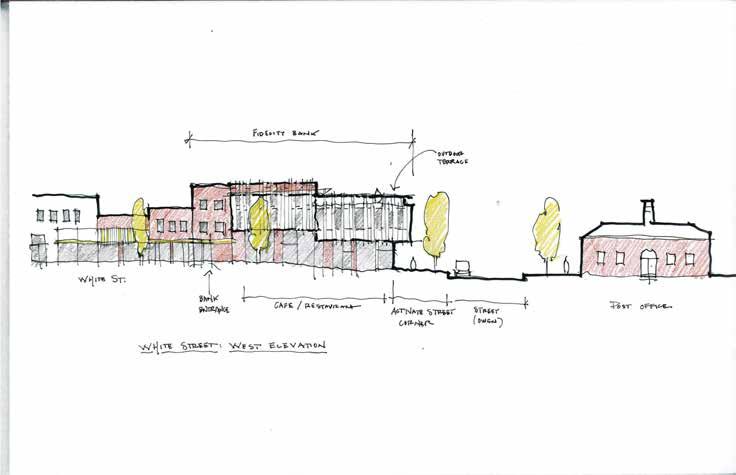
Opposite: The Perry Building reimagined by Brad Burns; This page, above: Fidelity Bank by Robby Johnson and Taylor Medlin; This page, below: Johnson Building/Victorian Square by Albert McDonald.
Erin Sterling Lewis, Tina Govan, and Julieta Sherk had already taken one walking tour that morning, during which Lewis had heard about foot paths along a natural stream partially covered by concrete and asphalt. Uncovering it might be an interesting idea, the three designers reasoned. Now, umbrellas in hand, the group slipped down to Miller Park, ran across Roosevelt Street, trudged up a residential footpath on the eastern fringe, then rambled down to the town cemetery. Along the way, they monitored their stream as it surfaced at grade level, disappeared underground, then popped back up again.
Returning to Town Hall, they huddled with three other architects earnestly engaged in sketching out their own design strategies. Michael Stevenson was hatching a plan for two urban “bookends” – a transportation hub at the town’s south end and a cultural hub at its north, with 1,600 linear feet of shops, homes, and offices on South White Street in between. Louis Cherry was drawing up a culinary incubator where multiple chefs could lease kitchen spaces, with a bar dropped strategically into its center. And Frank Harmon quietly sketched out a train station, a bus terminal, and residential units for the transportation hub.
Across the room, Matt Hale was working through drawings for a boutique hotel to stand next to a restaurant he’d already designed and built. Anthony Garcia was dreaming up ways to insert a wall of storefront glass into a brick facade along the town’s Roosevelt Street gateway.
Robby Johnson and Taylor Medlin were sketching out a pedestrian mall to link a pristine Town Hall with the messy vitality of commerce on White Street. Albert McDonald was working through plans for a rooftop bar on a restaurant he proposed for the intersection of White Street at Roosevelt Street. And Brad Burns was reinvigorating a forgotten Art Deco gem – transforming it from wood-paneled barbershop to light-infused cafe with indoor and outdoor seating.
It all took place in a tight window of time between 8:30 a.m. and 5:00 p.m., with presentations to town officials after-

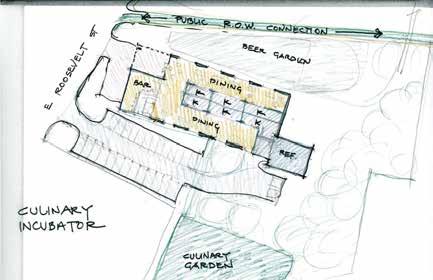
wards. The architects’ concepts are now slated for the Wake Forest Renaissance Plan – a toolbox of guidelines for future developers, investors, and property owners.
And if Wake Forest Mayor Vivian Jones has her way, each of these sketches will one day become reality. “As staff and elected officials go forward, and the private sector comes into downtown, they’ll show the ideas and encourage them to follow through with them,” she says. “If they do that with the architects, that would be great – but to follow through on them is what I anticipate.”
That would mean a series of positive eventual outcomes, including that daylit, holy grail of a stream, meandering in a park-like setting through the center of town.

IMAGINING WHAT COULD BE
Top: A culinary incubator by Louis Cherry; Bottom: Erin Sterling Lewis and Tina Govan reclaim a hidden stream.
FOOD FOR THOUGHT
Anyone considering the idea of opening a new restaurant in an old building would do well to listen to an expert on the process. That’s the logic that leaders of Wake Forest Downtown – the organization that presented and funded the October architectural charrette – applied when they invited Chef Matt Kelly, developer and owner of Durham’s Vin Rouge and Mateo restaurants, to brief 12 Raleigh architects studying their town.
Kelly spent an hour talking about the restaurant business, then fielded questions about buildings, parking, and funding. As it turns out, Wake Forest may be on the right track. “Right now, small Southern towns are on the upswing,” he says. “Davidson, N.C. has a restaurant that’s in the Bon Appétit top ten. And 10 years ago – a James Beard award in Raleigh? Who would think it?”
Kelly’s experienced. He’s opened up multiple restaurants in a single year – in Charlotte at SouthPark; in Wilmington; and in Durham at The Book Exchange – spending $2.5 million in the process. He likes corner locations for their visibility and parking. And he likes to be prepared before he makes a move – though intuition does play a role. “It’s a feeling – you look at a space and you know what it is,” he says. “With designers, you have to listen but not give up your vision. As an owner you have to fight for where the budget’s going.”
A restaurant’s concept and layout – plus how many diners show up – drive its profitability. Change a floor plan or add a feature, and you might lose money. “The layout is about what I can do with this space – how many seats with this concept in mind?” he says. “The concept is the variable. How much can I make from an individual in that seat? How much per square foot?”
And believe it or not, scarcity of parking spaces can be an asset, not a liability, in developing a restaurant for a small town. The more people on the sidewalks, the better the business for all. “Plan on not having (your own) parking – that’s part of the gig, because you have to walk and pass other businesses,” he says. “The key is to let people know where the parking is – you don’t want it to be a secret.”
Now that the economy’s on the rebound, there’s more willingness to invest in restaurants by property owners and even groups of individuals in the community. “A thousand people giving $500 each – it can work,” he says. “Anything can work.”
But, the veteran chef says, 50 percent of a restaurant’s success still depends on luck. –JMW
ILLUSTRATED INTERVIEW with Marvin Malecha
AFTER 21 YEARS AS DEAN OF THE COLLEGE OF DESIGN AT N.C. STATE UNIVERSITY, MARVIN Malecha retires this month and will become president and chief academic o cer at the NewSchool of Architecture and Design in San Diego, Calif. It seemed fi tting in this interview with WALTER to have the design visionary sketch his responses.
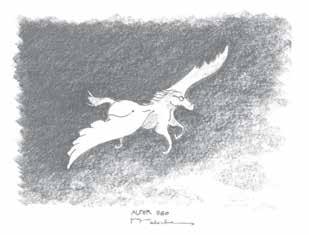
A fl ash of white hair Against a black image Defi ned by the geometry of eyewear Fueled by an open spirit? But what does it matter?
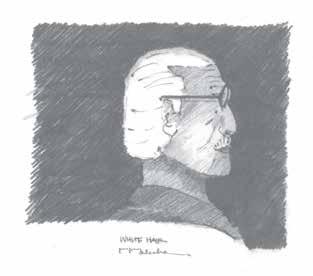
A building is a marker of life. It is architecture by its relationship to life. The vanishing tobacco barns are geniune. The Fadum House has a simple reality. The memory of the Catalano House haunts us. Dorton Arena reminds us of our better spirit, and the Hunt Library transforms our understanding.

WHAT DO YOU LOOK LIKE?
WHICH BUILDING IN RALEIGH DO YOU MOST ADMIRE? DO YOU HAVE AN ALTER EGO?

WHAT’S YOUR FAVORITE THING TO EAT?
Yes and no. It is a circus. Friends Mentors Role models Composed into an idealized aspiration. My alter ego has wings.
In my personal quiet space A rich Italian red – Brunello and a bold cheese With my joy A soft black licorice with my granddaughter So it depends ...
WHAT ARE YOU AFRAID OF?
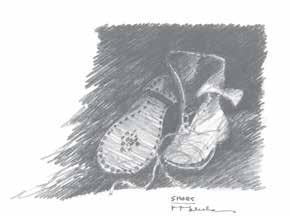
FEAR To restrict my curiosity To cup my wings The authority of those who would seize my independence

CYNICISM To drain me of my energy Driving color from my mind
WHAT IS YOUR FAVORITE SEASON?

The season I am alive in! I am moved by the quiet of a snowfall and the crackle of the fi rst steps in it. Who cannot be astounded by the brilliance of the color of a youthful spring? The lustiness of summer speaks for itself. But the beautiful subtlety of fall ... the mature spectrum of color ... the instigation ... the demand for refl ection – makes it my favorite. WHAT’S ON YOUR FEET?

A message, a dialogue of Van Gogh, Heidegger, and Charlie Chaplin ... Cole Hahn high tops today Mephisto for comfort yesterday Asics from my son for exercise My identity!
WHAT’S ON YOUR MIND?
The past near and far Today ... NOW! The transition to the future. Satisfaction for what has been Impatience to be better Possibilities Color!






